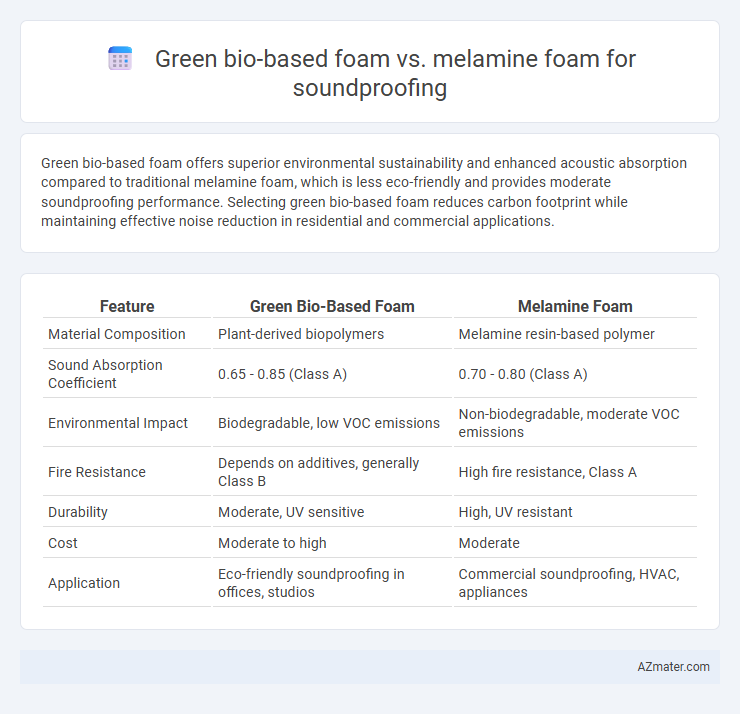Green bio-based foam offers superior environmental sustainability and enhanced acoustic absorption compared to traditional melamine foam, which is less eco-friendly and provides moderate soundproofing performance. Selecting green bio-based foam reduces carbon footprint while maintaining effective noise reduction in residential and commercial applications.
Table of Comparison
| Feature | Green Bio-Based Foam | Melamine Foam |
|---|---|---|
| Material Composition | Plant-derived biopolymers | Melamine resin-based polymer |
| Sound Absorption Coefficient | 0.65 - 0.85 (Class A) | 0.70 - 0.80 (Class A) |
| Environmental Impact | Biodegradable, low VOC emissions | Non-biodegradable, moderate VOC emissions |
| Fire Resistance | Depends on additives, generally Class B | High fire resistance, Class A |
| Durability | Moderate, UV sensitive | High, UV resistant |
| Cost | Moderate to high | Moderate |
| Application | Eco-friendly soundproofing in offices, studios | Commercial soundproofing, HVAC, appliances |
Introduction to Acoustic Foam Technologies
Green bio-based foam and melamine foam represent two prominent acoustic foam technologies used for soundproofing solutions. Green bio-based foam is derived from renewable resources, offering eco-friendly sound absorption with effective noise reduction properties suitable for residential and commercial applications. Melamine foam features an open-cell structure providing superior sound absorption across a broad frequency range, commonly utilized in professional studios and industrial noise control.
Understanding Green Bio-Based Foam
Green bio-based foam, made from renewable resources such as plant oils and agricultural byproducts, offers eco-friendly soundproofing with superior breathability and moisture resistance compared to traditional melamine foam. This sustainable material provides effective acoustic absorption by disrupting sound waves within its porous structure, making it ideal for indoor sound control in residential and commercial spaces. Green bio-based foam also features enhanced thermal insulation and biodegradability, reducing environmental impact while maintaining long-term performance.
Overview of Melamine Foam
Melamine foam is a lightweight, open-cell material renowned for its superior sound absorption and fire resistance, making it ideal for soundproofing applications in construction and automotive industries. Its unique microstructure effectively reduces mid to high-frequency noise by trapping sound waves, while being resistant to moisture and chemical degradation. Compared to green bio-based foams, melamine foam offers enhanced durability and thermal stability, though it lacks the environmental benefits of sustainable sourcing and biodegradability.
Environmental Impact Comparison
Green bio-based foam significantly reduces carbon footprint due to its renewable raw materials and biodegradability, contrasting with melamine foam, which relies on petrochemical processes and presents challenges in recycling. The production of bio-based foam minimizes toxic emissions and energy consumption, while melamine foam manufacturing involves higher greenhouse gas emissions and generates non-biodegradable waste. Environmental assessments highlight that green bio-based foam supports sustainable soundproofing solutions with lower global warming potential and improved end-of-life disposal options.
Acoustic Performance: Absorption and Insulation
Green bio-based foam demonstrates superior acoustic absorption with high noise reduction coefficients (NRC), effectively minimizing sound reflections and echoes in indoor environments. Melamine foam offers excellent sound insulation due to its open-cell structure, efficiently trapping airborne noise and providing thermal insulation benefits. While both materials perform well in acoustic applications, bio-based foam excels in sustainable sound absorption, whereas melamine foam is preferred for comprehensive noise damping and thermal resistance.
Fire Resistance and Safety Standards
Green bio-based foam offers superior fire resistance compared to melamine foam, meeting stringent safety standards such as ASTM E84 Class A rating, which indicates low flame spread and smoke development. Melamine foam, while lightweight and effective for soundproofing, generally exhibits lower fire-resistance performance, often classified under ASTM E84 Class B or C, which implies higher combustibility. Prioritizing materials that comply with international fire safety regulations ensures both effective soundproofing and enhanced occupant safety in residential and commercial applications.
Durability and Longevity
Green bio-based foam offers superior durability and longevity compared to melamine foam, retaining its soundproofing properties over extended periods without significant degradation. Its natural composition resists cracking and crumbling, making it ideal for long-term acoustic insulation applications. Melamine foam, while effective in sound absorption, tends to be more brittle and can deteriorate faster under environmental stress, reducing its lifespan.
Installation and Maintenance Considerations
Green bio-based foam offers easier installation due to its lightweight and flexible properties, allowing it to conform to irregular surfaces without heavy tools. It requires minimal maintenance, as it is resistant to mold and moisture, reducing the need for frequent cleaning or replacement. Melamine foam, though effective in sound absorption, can be rigid and brittle, making installation more labor-intensive and necessitating careful handling to avoid damage during fitting and upkeep.
Cost Analysis: Initial and Long-term Expenses
Green bio-based foam generally presents a higher initial cost compared to melamine foam due to its sustainable raw materials and manufacturing processes. However, over the long term, green bio-based foam often proves more cost-effective by offering greater durability, biodegradability, and reduced environmental impact, which can lower disposal and replacement expenses. Melamine foam, while cheaper upfront, may incur higher costs over time due to less sustainability and shorter lifespan in intensive soundproofing applications.
Choosing the Best Foam for Your Soundproofing Needs
Green bio-based foam offers sustainable soundproofing with excellent noise absorption and environmental benefits, making it ideal for eco-conscious projects. Melamine foam provides superior fire resistance and effective high-frequency sound attenuation, suitable for commercial and industrial applications. Selecting the best foam depends on balancing soundproofing performance, fire safety requirements, and environmental impact for your specific space.

Infographic: Green bio-based foam vs Melamine foam for Soundproofing
 azmater.com
azmater.com